The global pharmaceutical mini batch blender market is projected to grow from USD 675.9 million in 2025 to approximately USD 1,674.9 million by 2035, recording an absolute increase of USD 999 million over the forecast period. This translates into a total growth of 147.8%, with the market forecast to expand at a compound annual growth rate (CAGR) of 9.5% between 2025 and 2035.
The overall market size is expected to grow by nearly 2.5X during the same period, supported by the rising adoption of personalized medicine manufacturing and increasing demand for flexible pharmaceutical production solutions in small-scale drug development, clinical trial support, and specialty pharmaceutical manufacturing applications.
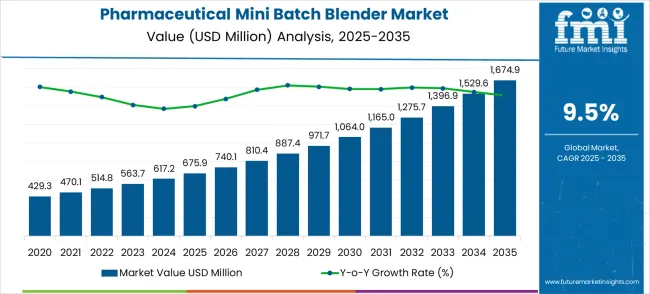
Between 2025 and 2030, the pharmaceutical mini batch blender market is projected to expand from USD 675.9 million to USD 1,064 million, resulting in a value increase of USD 388.1 million, which represents 38.9% of the total forecast growth for the decade.
This phase of growth will be shaped by rising penetration of personalized medicine manufacturing, increasing demand for flexible pharmaceutical production equipment, and growing adoption of small-scale manufacturing technologies in drug development processes. Equipment manufacturers are expanding their mini batch blending capabilities to address the growing complexity of modern pharmaceutical manufacturing requirements and regulatory compliance demands.
The pharmaceutical mini batch blender market holds about 5% of the share within the pharmaceutical equipment market, driven by the demand for small-scale, efficient blending solutions in pharmaceutical production. In the industrial mixing equipment market, it captures approximately 7%, as mini batch blenders are favored for their precision and ability to handle small quantities.
Within the pharmaceutical manufacturing market, the market share is around 6%, as mini batch blenders are integral in the formulation and production of small batch drugs. The processing equipment market sees about 4%, reflecting the growing need for specialized equipment that meets regulatory requirements and production flexibility.
In the laboratory equipment market, it holds approximately 3%, as mini batch blenders are used in pharmaceutical R&D for formulation testing and process optimization. These figures highlight the significant role mini batch blenders play in enhancing efficiency and quality in pharmaceutical production and research.
| Metric | Value |
|---|---|
| Market Value (2025) | USD 675.9 million |
| Market Forecast Value (2035) | USD 1,674.9 million |
| Market Forecast CAGR | 9.5% |
Market expansion is being supported by the rapid increase in personalized medicine development worldwide and the corresponding need for flexible manufacturing equipment that provides precise blending capabilities and adaptable production scales for diverse pharmaceutical formulation requirements.
Modern pharmaceutical facilities rely on mini batch blenders to deliver consistent product quality and comprehensive process control including clinical trial manufacturing, specialty drug production, and research formulation development. Even minor blending inconsistencies can require comprehensive manufacturing protocol adjustments to maintain optimal product uniformity and regulatory compliance.
The growing complexity of pharmaceutical formulation requirements and increasing demand for agile manufacturing solutions are driving demand for mini batch blender equipment from certified pharmaceutical equipment manufacturers with appropriate cGMP capabilities and regulatory expertise.
Pharmaceutical companies and contract manufacturers are increasingly requiring documented blending performance and process validation to maintain product quality and regulatory compliance. Industry specifications and pharmaceutical regulations are establishing standardized blending procedures that require specialized pharmaceutical technologies and trained process engineers.
The Pharmaceutical Mini Batch Blender market is entering a new phase of robust growth, driven by demand for personalized medicine, manufacturing flexibility, and evolving pharmaceutical production standards. By 2035, these pathways together can unlock USD 350-450 million in incremental revenue opportunities beyond baseline growth.
Pathway A - Mobile Blending Systems Leadership (Flexible Manufacturing)
Pathway B - Specialty Pharmaceutical Manufacturing (High-Value Formulations)
Pathway C - Personalized Medicine Production (Patient-Specific Manufacturing)
Pathway D - Continuous Manufacturing Integration (Hybrid Processing)
Pathway E - Clinical Trial Manufacturing (Development Support)
Pathway F - High-Containment Applications (Potent Compounds)
Pathway G - Emerging Market Expansion (Local Manufacturing)
Pathway H - Digital Integration and Industry 4.0
The market is segmented by type, application, and region. By type, the market is divided into mobile and stationary. Based on application, the market is categorized into pilot and small batches production. Regionally, the market is divided into North America, Europe, East Asia, South Asia & Pacific, Latin America, and Middle East & Africa.
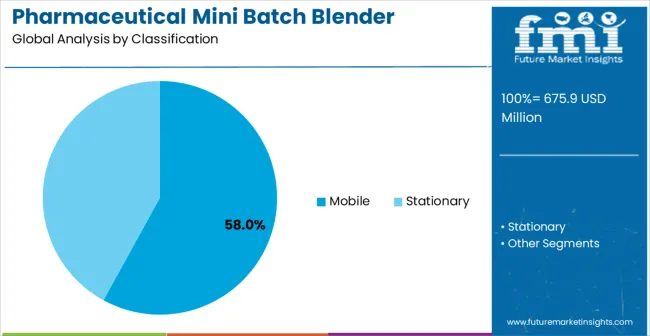
In 2025, the mobile pharmaceutical mini batch blender segment is projected to capture around 58% of the total market share, making it the leading product category. This dominance is largely driven by the widespread adoption of flexible blending systems that provide enhanced operational versatility and space utilization efficiency, catering to a wide variety of pharmaceutical manufacturing environments with changing production needs. Mobile blending technology is particularly favored for its ability to serve multiple production lines and formulation projects while ensuring contamination prevention and cleaning validation compliance.
Pharmaceutical companies, contract development organizations, biotechnology firms, and clinical manufacturing facilities increasingly prefer mobile systems, as they meet diverse blending requirements without requiring permanent installation commitments or extensive facility modifications.
The availability of well-established mobile blender designs, along with comprehensive validation documentation and technical support from leading pharmaceutical equipment manufacturers, further reinforces the segment's market position.
Additionally, this type category benefits from consistent demand across regions, as it is considered a practical high-flexibility solution for facilities requiring adaptable manufacturing capabilities. The combination of operational flexibility, space efficiency, and validation compliance makes mobile pharmaceutical mini batch blenders a preferred choice, ensuring their continued popularity in the pharmaceutical manufacturing equipment market.
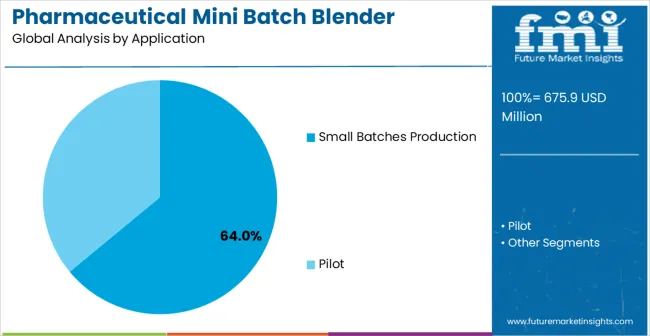
The small batches production segment is expected to represent 64% of pharmaceutical mini batch blender demand in 2025, highlighting its position as the most significant application sector. This dominance stems from the unique operational needs of specialized pharmaceutical manufacturing, where precise formulation control and efficient small-scale production are critical to product quality and market responsiveness.
Small batch production facilities often feature diverse product portfolios that require frequent changeovers throughout extended manufacturing campaigns, demanding flexible and reliable blending equipment. Pharmaceutical mini batch blenders are particularly well-suited to these environments due to their ability to deliver consistent blending results across varying batch sizes and formulation complexities, even during rapid product changeover operations.
As pharmaceutical companies globally advance toward precision medicine and specialty drug manufacturing, the demand for small batch production capabilities continues to rise. The segment also benefits from increased investment in orphan drug development and personalized therapy programs, where manufacturers are increasingly prioritizing manufacturing flexibility and product customization as essential competitive advantages.
With pharmaceutical companies investing in agile manufacturing systems and specialized product development, mini batch blenders provide an essential solution to maintain superior production flexibility. The growth of specialty pharmaceuticals, biosimilar manufacturing, and personalized medicine applications, coupled with increased focus on manufacturing agility, ensures that small batches production will remain the largest and most stable demand driver for pharmaceutical mini batch blenders in the forecast period.
The Pharmaceutical Mini Batch Blender market is advancing rapidly due to increasing personalized medicine development and growing recognition of flexible manufacturing advantages in pharmaceutical production over large-scale batch manufacturing approaches. However, the market faces challenges including higher per-unit manufacturing costs compared to large-scale production equipment, complex validation requirements for pharmaceutical applications, and varying regulatory standards across different geographic regions. Performance optimization efforts and process validation programs continue to influence equipment development and market adoption patterns.
The growing development of continuous manufacturing technologies is enabling seamless integration with traditional batch processing while providing enhanced process efficiency and improved product consistency. Advanced continuous-batch hybrid systems and optimized process integration provide superior manufacturing flexibility while maintaining pharmaceutical quality standards. These technologies are particularly valuable for pharmaceutical companies and contract manufacturers who require reliable production systems that can support diverse manufacturing requirements with consistent quality performance.
Modern pharmaceutical mini batch blender manufacturers are incorporating advanced process analytical technology and real-time monitoring systems that enhance blending precision and process validation capabilities. Integration of automated process control and digital quality systems enables superior manufacturing consistency and comprehensive documentation capabilities. Advanced control features support operation in diverse pharmaceutical environments while meeting various regulatory requirements and validation specifications.
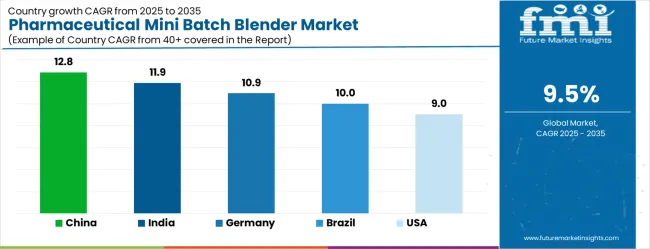
| Country | CAGR (2025-2035) |
|---|---|
| China | 12.8% |
| India | 11.9% |
| Germany | 10.9% |
| Brazil | 10.0% |
| United States | 9.0% |
| United Kingdom | 8.1% |
| Japan | 7.1% |
The pharmaceutical mini batch blender market is experiencing strong growth, with China leading at a 12.8% CAGR through 2035, driven by rapid pharmaceutical industry expansion and increasing adoption of flexible manufacturing technologies across generic drug production, specialty pharmaceutical development, and clinical manufacturing sectors. India follows at 11.9%, supported by rising contract manufacturing industry growth and growing demand for cost-effective pharmaceutical production solutions for domestic and export markets.
Germany grows robustly at 10.9%, integrating mini batch blending technology into its established pharmaceutical manufacturing and biotechnology infrastructure. Brazil records 10.0%, emphasizing pharmaceutical industry modernization and specialty drug manufacturing advancement initiatives.
The United States shows substantial growth at 9.0%, focusing on personalized medicine development and advanced pharmaceutical manufacturing innovation. The United Kingdom demonstrates strong progress at 8.1%, maintaining established pharmaceutical manufacturing applications and biotechnology research leadership. Japan records 7.1% growth, concentrating on precision pharmaceutical manufacturing and high-quality drug production standards.
The report covers an in-depth analysis of 40+ countries, the top-performing countries are highlighted below.
The pharmaceutical mini batch blender market in China is projected to exhibit the highest growth rate with a CAGR of 12.8% through 2035, driven by massive pharmaceutical industry expansion programs and increasing demand for flexible manufacturing equipment across generic drug production, specialty pharmaceutical manufacturing, and clinical research sectors. The country's aggressive pharmaceutical modernization and growing domestic drug development capabilities are creating significant demand for advanced mini batch blending systems. Major pharmaceutical companies and contract manufacturers are establishing comprehensive flexible manufacturing facilities to support the increasing requirements of drug development organizations and pharmaceutical production facilities across major pharmaceutical industrial parks.
National pharmaceutical development initiatives are supporting establishment of world-class pharmaceutical manufacturing facilities and biotechnology centers, driving demand for advanced blending equipment throughout major pharmaceutical development zones. Pharmaceutical industry modernization programs are facilitating adoption of flexible manufacturing technologies that enhance production capabilities and regulatory compliance across pharmaceutical supply chains.
The pharmaceutical mini batch blender market in India is expanding at a CAGR of 11.9%, supported by increasing contract pharmaceutical manufacturing industry development and growing awareness of flexible production technology benefits for cost-effective pharmaceutical manufacturing. The country's expanding pharmaceutical sector and rising generic drug production standards are driving demand for advanced mini batch blending solutions. Pharmaceutical companies and contract development organizations are gradually implementing professional-grade blending equipment to maintain production efficiency and international quality standards.
Pharmaceutical industry growth and contract manufacturing development are creating opportunities for equipment suppliers that can support diverse production requirements and pharmaceutical manufacturing specifications. Professional training and development programs are building technical expertise among pharmaceutical engineers, enabling effective utilization of mini batch blending technology that meets pharmaceutical standards and regulatory requirements.
The pharmaceutical mini batch blender market in Germany is projected to grow at a CAGR of 10.9%, supported by the country's emphasis on pharmaceutical manufacturing quality standards and advanced biotechnology production adoption. German pharmaceutical companies and biotechnology manufacturers are implementing cutting-edge mini batch blending systems that meet stringent performance requirements and regulatory specifications. The market is characterized by focus on equipment reliability, process validation, and compliance with comprehensive pharmaceutical engineering standards.
Pharmaceutical manufacturing industry investments are prioritizing advanced blending technology that demonstrates superior performance and regulatory compliance while meeting German quality and international pharmaceutical standards. Professional certification programs are ensuring comprehensive technical expertise among pharmaceutical and biotechnology engineers, enabling specialized blending system capabilities that support diverse pharmaceutical applications and production requirements.
The pharmaceutical mini batch blender market in Brazil is growing at a CAGR of 10.0%, driven by increasing pharmaceutical facility modernization and growing recognition of flexible manufacturing advantages for specialty pharmaceutical production. The country's expanding pharmaceutical sector is gradually integrating advanced blending equipment to enhance production efficiency and product quality standards. Pharmaceutical companies and manufacturing organizations are investing in mini batch blending technology to address evolving regulatory expectations and market competitiveness.
Pharmaceutical modernization is facilitating adoption of advanced manufacturing technologies that support comprehensive pharmaceutical production capabilities across pharmaceutical regions. Professional development programs are enhancing technical capabilities among pharmaceutical engineers, enabling effective mini batch blender utilization that meets evolving pharmaceutical standards and production requirements.
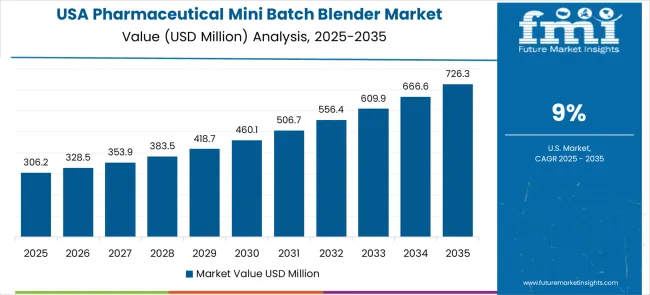
The pharmaceutical mini batch blender market in the USA is expanding at a CAGR of 9.0%, driven by established pharmaceutical industry leadership and growing emphasis on personalized medicine development and advanced pharmaceutical manufacturing innovation. Large pharmaceutical companies and biotechnology firms are implementing comprehensive mini batch blending capabilities to serve diverse drug development and commercial manufacturing requirements. The market benefits from established pharmaceutical equipment networks and professional training programs that support various pharmaceutical and biotechnology applications.
Pharmaceutical industry leadership is enabling standardized blending technology utilization across multiple production types, providing consistent manufacturing quality and comprehensive process coverage throughout regional pharmaceutical markets. Professional development and certification programs are building specialized technical expertise among pharmaceutical and biotechnology engineers, enabling effective mini batch blender utilization that supports evolving pharmaceutical production requirements.
The pharmaceutical mini batch blender market in the UK is projected to grow at a CAGR of 8.1%, supported by established pharmaceutical technology sectors and growing emphasis on biotechnology manufacturing capabilities. British pharmaceutical companies and biotechnology providers are implementing mini batch blending equipment that meets industry pharmaceutical standards and regulatory requirements. The market benefits from established pharmaceutical infrastructure and comprehensive training programs for pharmaceutical professionals.
Pharmaceutical technology investments are prioritizing advanced blending systems that support diverse pharmaceutical applications while maintaining established quality and regulatory standards. Professional development programs are building pharmaceutical expertise among technology personnel, enabling specialized mini batch blender operation capabilities that meet evolving institutional requirements and pharmaceutical technology standards.
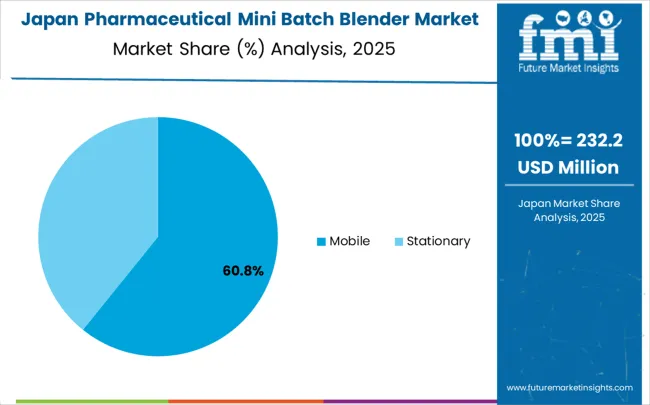
The pharmaceutical mini batch blender market in Japan is growing at a CAGR of 7.1%, driven by the country's focus on precision pharmaceutical manufacturing innovation and ultra-high quality drug production applications.
Japanese pharmaceutical companies and biotechnology manufacturers are implementing advanced mini batch blending systems that demonstrate superior precision reliability and operational excellence. The market is characterized by emphasis on technological perfection, quality assurance, and integration with established pharmaceutical manufacturing workflows.
Pharmaceutical technology industry investments are prioritizing innovative blending solutions that combine advanced mini batch technology with precision engineering while maintaining Japanese pharmaceutical quality and reliability standards. Professional development programs are ensuring comprehensive technical expertise among pharmaceutical engineers and quality specialists, enabling specialized precision blending capabilities that support diverse pharmaceutical applications and quality requirements.
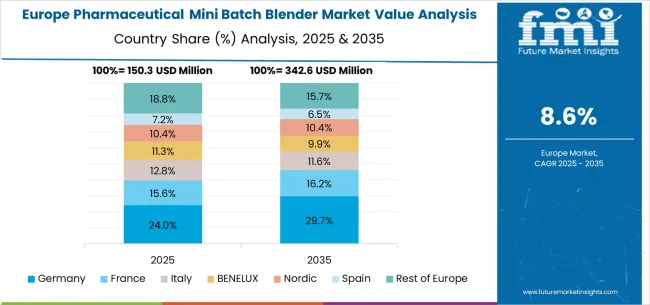
The pharmaceutical mini batch blender market in Europe is forecast to expand from USD 176.5 million in 2025 to USD 437.5 million by 2035, registering a CAGR of 9.5%. Germany will remain the largest market, holding 35.0% share in 2025, easing to 34.5% by 2035, supported by strong pharmaceutical manufacturing infrastructure and advanced biotechnology production capabilities.
The United Kingdom follows, rising from 27.5% in 2025 to 28.0% by 2035, driven by pharmaceutical technology innovation and biotechnology research advancement. France is expected to maintain stability around 21.0%, reflecting steady pharmaceutical investment patterns.
Italy maintains stability at around 10.0%, supported by pharmaceutical manufacturing and specialty drug production growth, while Spain grows from 4.5% to 5.0% with expanding pharmaceutical infrastructure and manufacturing modernization. BENELUX markets ease from 1.8% to 1.7%, while the remainder of Europe hovers near 0.2%-0.3%, balancing emerging Eastern European pharmaceutical development against mature Nordic pharmaceutical manufacturing markets.
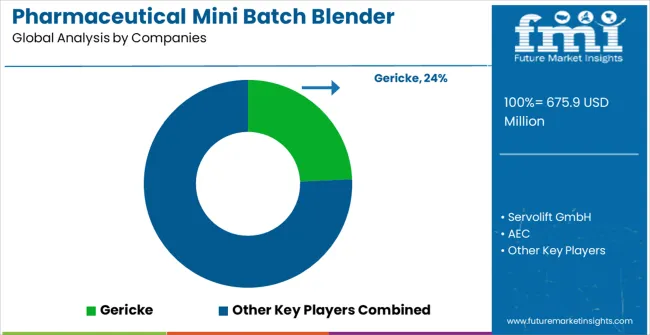
The Pharmaceutical Mini Batch Blender market is defined by competition among specialized pharmaceutical equipment manufacturers, process technology companies, and pharmaceutical engineering solution providers.
Companies are investing in advanced blending algorithm development, process control optimization, validation system improvements, and comprehensive pharmaceutical application capabilities to deliver reliable, compliant, and cost-effective pharmaceutical manufacturing solutions. Strategic partnerships, technological innovation, and market expansion are central to strengthening product portfolios and market presence.
Gericke offers comprehensive powder processing solutions with established pharmaceutical blending expertise and cGMP-compliant manufacturing capabilities. Servolift GmbH provides specialized pharmaceutical handling equipment with focus on containment systems and process integration solutions.
AEC delivers advanced mixing and blending technology with emphasis on pharmaceutical process validation and regulatory compliance. MUNSON specializes in industrial mixing equipment with comprehensive pharmaceutical application integration.
Pharmag offers pharmaceutical processing equipment with focus on small-scale manufacturing and pilot plant applications. Conta provides powder handling solutions with emphasis on pharmaceutical containment and material transfer systems. These companies, along with other industry participants, offer specialized pharmaceutical expertise, equipment reliability, and comprehensive technology development across global and regional pharmaceutical manufacturing market segments.
| Item | Value |
|---|---|
| Quantitative Units | USD 675.9 million |
| Type | Mobile, Stationary |
| Application | Pilot, Small Batches Production |
| Regions Covered | North America, Europe, East Asia, South Asia & Pacific, Latin America, Middle East & Africa |
| Country Covered | China, India, Germany, Brazil, United States, United Kingdom, Japan, and 40+ countries |
| Key Companies Profiled | Gericke, Servolift GmbH, AEC, MUNSON, Pharmag, Conta |
| Additional Attributes | Dollar sales by type and application segment, regional demand trends across major markets, competitive landscape with established pharmaceutical equipment manufacturers and emerging process technology providers, customer preferences for different blending configurations and containment options, integration with pharmaceutical manufacturing systems and quality control protocols, innovations in process control technology and validation capabilities, and adoption of digital monitoring features with enhanced compliance capabilities for improved pharmaceutical manufacturing workflows. |
The global turquoise bracelets market is estimated to be valued at USD 417.2 million in 2025.
The market size for the turquoise bracelets market is projected to reach USD 726.3 million by 2035.
The turquoise bracelets market is expected to grow at a 5.7% CAGR between 2025 and 2035.
The key product types in turquoise bracelets market are inlaid bracelets, beaded bracelets and others.
In terms of application, decoration segment to command 70.0% share in the turquoise bracelets market in 2025.






Our Research Products

The "Full Research Suite" delivers actionable market intel, deep dives on markets or technologies, so clients act faster, cut risk, and unlock growth.

The Leaderboard benchmarks and ranks top vendors, classifying them as Established Leaders, Leading Challengers, or Disruptors & Challengers.

Locates where complements amplify value and substitutes erode it, forecasting net impact by horizon

We deliver granular, decision-grade intel: market sizing, 5-year forecasts, pricing, adoption, usage, revenue, and operational KPIs—plus competitor tracking, regulation, and value chains—across 60 countries broadly.

Spot the shifts before they hit your P&L. We track inflection points, adoption curves, pricing moves, and ecosystem plays to show where demand is heading, why it is changing, and what to do next across high-growth markets and disruptive tech

Real-time reads of user behavior. We track shifting priorities, perceptions of today’s and next-gen services, and provider experience, then pace how fast tech moves from trial to adoption, blending buyer, consumer, and channel inputs with social signals (#WhySwitch, #UX).

Partner with our analyst team to build a custom report designed around your business priorities. From analysing market trends to assessing competitors or crafting bespoke datasets, we tailor insights to your needs.
Supplier Intelligence
Discovery & Profiling
Capacity & Footprint
Performance & Risk
Compliance & Governance
Commercial Readiness
Who Supplies Whom
Scorecards & Shortlists
Playbooks & Docs
Category Intelligence
Definition & Scope
Demand & Use Cases
Cost Drivers
Market Structure
Supply Chain Map
Trade & Policy
Operating Norms
Deliverables
Buyer Intelligence
Account Basics
Spend & Scope
Procurement Model
Vendor Requirements
Terms & Policies
Entry Strategy
Pain Points & Triggers
Outputs
Pricing Analysis
Benchmarks
Trends
Should-Cost
Indexation
Landed Cost
Commercial Terms
Deliverables
Brand Analysis
Positioning & Value Prop
Share & Presence
Customer Evidence
Go-to-Market
Digital & Reputation
Compliance & Trust
KPIs & Gaps
Outputs
Full Research Suite comprises of:
Market outlook & trends analysis
Interviews & case studies
Strategic recommendations
Vendor profiles & capabilities analysis
5-year forecasts
8 regions and 60+ country-level data splits
Market segment data splits
12 months of continuous data updates
DELIVERED AS:
PDF EXCEL ONLINE
Pharmaceutical Autoclave Machine Market Size and Share Forecast Outlook 2025 to 2035
Pharmaceutical Excipient SNAC Market Size and Share Forecast Outlook 2025 to 2035
Pharmaceutical Zinc Powder Market Size and Share Forecast Outlook 2025 to 2035
Pharmaceutical Grade Magnesium Sulfate Market Size and Share Forecast Outlook 2025 to 2035
Pharmaceutical Secondary Packaging Market Size and Share Forecast Outlook 2025 to 2035
Pharmaceutical Glass Packaging Market Size and Share Forecast Outlook 2025 to 2035
Pharmaceutical Manufacturing Equipment Market Forecast and Outlook 2025 to 2035
Pharmaceutical Plastic Bottle Market Forecast and Outlook 2025 to 2035
Pharmaceutical Grade Sodium Carbonate Market Forecast and Outlook 2025 to 2035
Pharmaceutical Industry Analysis in Saudi Arabia Forecast and Outlook 2025 to 2035
Pharmaceutical Packaging Market Size and Share Forecast Outlook 2025 to 2035
Pharmaceutical Grade Sodium Chloride Market Size and Share Forecast Outlook 2025 to 2035
Pharmaceutical Plastic Packaging Market Size and Share Forecast Outlook 2025 to 2035
Pharmaceutical Plastic Pots Market Size and Share Forecast Outlook 2025 to 2035
Pharmaceuticals Pouch Market Size and Share Forecast Outlook 2025 to 2035
Pharmaceutical Unit Dose Packaging Market Size and Share Forecast Outlook 2025 to 2035
Pharmaceutical Continuous Manufacturing Equipment Market Size and Share Forecast Outlook 2025 to 2035
Pharmaceutical Liquid Prefilters Market Size and Share Forecast Outlook 2025 to 2035
Pharmaceutical Grade P-Toluenesulfonic Acid Market Size and Share Forecast Outlook 2025 to 2035
Pharmaceutical Glass Container Industry Analysis in Europe Size and Share Forecast Outlook 2025 to 2035

Thank you!
You will receive an email from our Business Development Manager. Please be sure to check your SPAM/JUNK folder too.
Chat With
MaRIA